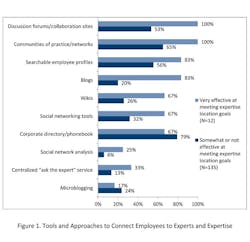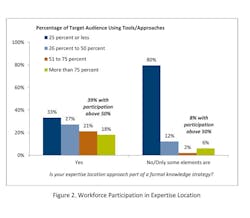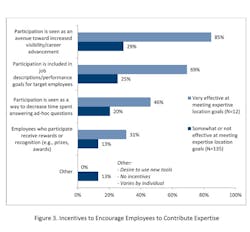Five Tips for Improving How Employees Access Experts and Expertise
A majority of organizations are experiencing demographic shifts in their workforces, with the Baby Boomers starting to retire en masse, Millennials comprising an ever-larger percentage of staff, and Generation X-ers moving up the career ladder to take on positions requiring more expertise and judgment. In environments with few experts and many potential learners, experts and long-tenured employees need to be able to share their knowledge broadly and efficiently across the workforce. At the same time, less experienced colleagues need ways to ask questions, get information and advice, and solve problems collaboratively.
In 2013, member-based nonprofit APQC surveyed more than 100 organizations to learn what tools and approaches they use to surface experts within the workforce—and which achieve the best results. Some of the participating organizations reported having official expertise location programs managed by HR, knowledge management, or a technical center of excellence, but others rely on more piecemeal approaches with different tools supported by different groups. Regardless of the level of formality applied to expertise location, APQC recommends adhering to the following five guidelines to ensure employees have ready access to experts and knowledgeable people across large, dispersed organizations.
Combine employee profiles with communities, discussion forums and social networking
Among the tools and approaches that organizations use for expertise location, communities of practice, discussion boards, and LinkedIn-style employee profiles are the most popular, especially at organizations that consider themselves very effective at meeting their expertise location goals (Figure 1). Survey participants also rate these three approaches as the most valuable for expertise location. Overall, organizations tend to favor tools and approaches that combine access to experts with meaningful opportunities for communication, collaboration and networking.
Many firms also rely on blogs, wikis and social networking to surface experts and knowledgeable people, but these tools complement, rather than replace, the three core approaches mentioned above. A relatively low percentage of organizations use microblogging for expertise location, though other APQC research suggests that tools like Yammer are slowly catching on.
Base expertise designations on what employees contribute, not just their job titles
Perhaps even more important than the specific tools an organization uses for expertise location are the types of data used to determine who qualifies as an expert. When APQC asked about this, the most interesting results related to the ability to identify experts and go-to people based on their contributions and behaviors.
At organizations where this is possible, employees can surface knowledgeable colleagues based not only on the job titles and expertise areas listed in their profiles, but also on the actions they take—the articles and wiki pages they author, the communities to which they belong, the discussion threads in which they participate, and so on. Such data tends to provide a more holistic, accurate picture of which colleagues are most knowledgeable about a particular topic and who will be willing to share advice and expertise.
Based on the survey data, the ability to identify experts based on contributions and behaviors is strongly correlated with the effectiveness of an organization’s expertise location program. One-hundred percent of participants that report being very effective at meeting their expertise location goals provide this capability, compared with only 27% of other organizations.
Be prepared to customize software and link it to other data sources
APQC’s data suggests that, while most organizations do not need to build expensive in-house applications for expertise location, a little tweaking may be necessary to adapt commercial software to fit the needs of a specific workforce. Around 60% of participants use Microsoft SharePoint as their primary expertise location platform, but the vast majority customize at least some aspects of the software, rather than deploying it out of the box. Only 15% rely on free or off-the-shelf software, and these organizations report relatively low workforce participation rates.
In addition, organizations achieving the best results tend to integrate their expertise locators with other databases so they can auto-populate certain fields in employee profiles. Most profile systems require people to self-report information about themselves and their areas of expertise, but organizations can take some of this burden off employees’ shoulders by feeding basic data such as job role, years of tenure and past projects from HR and operations databases. Employees are more likely to complete their profiles if they do not have to waste time entering boilerplate, and automation helps ensure that profiles stay up-to-date when employees move to new roles and projects.
Make access to experts and expertise part of a broader strategy guiding the flow of knowledge
Organizations that want to maximize the value of their internal experts should build expertise location into broader strategies designed to move content and knowledge effectively through the enterprise. Organizations where expertise location is supported by a solid strategy tend to provide more options to surface experts and expertise, and they also report higher rates of engagement and participation among the target workforce. For example, 39% of organizations that incorporate expertise location into broader knowledge strategies achieve participation rates of 50% or above, compared to only 8% for organizations that do not (Figure 2).
Links to strategy are similarly correlated to higher rates of perceived effectiveness: 83% of organizations that report being very effective at meeting their expertise location goals indicate their approaches are part of formal knowledge strategies, compared to only 31% whose organizations are somewhat or not at all effective.
Why do organizations that tie expertise location to a broader knowledge strategy achieve better results? First, a formal knowledge management program provides an obvious “home” for expertise location, increasing the probability it will receive significant attention and funding. Links to strategy also suggest that an organization has thought deliberately and holistically about tools to connect people to experts and expertise, rather than implementing solutions ad-hoc to fill a particular need. By approaching expertise location as a business priority supported by a clear plan of action, leaders communicate its importance and are more likely to get buy-in from managers and experts.
Give employees reasons to participate
Not surprisingly, organizations that communicate the importance of expertise location and provide incentives to use the tools report significantly higher rates of both participation and effectiveness. For most organizations, the biggest barrier to participation is that people feel they are too busy, but this can be addressed by specifically allocating time for employees to seek and supply expertise.
The survey results suggest that this change can have a big impact: 44% of organizations that allot time for employees to answer questions and expertise requests achieve at least a 50% participation rate, compared to only 15% of organizations that encourage employees to participate but do not set aside time for them to do so.
Expertise location programs can also increase participation by:
• ensuring employees are aware of the available tools,
• providing training on how to use them,
• communicating the benefits for both experts and learnings, and
• creating recognition schemes to encourage desired behaviors.
Organizations that include expertise location in job descriptions and performance goals, and whose employees believe their expertise contributions will help advance their careers, are most effective at achieving their expertise location goals (Figure 3).
Overall, a successful expertise location implementation is most assured when employees see participation as part of their jobs and understand how applying knowledge and expertise across the organization can help avoid costly mistakes and boost overall performance.
Lauren Trees is a knowledge management research program manager with APQC, a member-based nonprofit and one of the leading proponents of benchmarking and best practice business research. Working with more than 500 organizations worldwide in all industries, APQC focuses on providing organizations with the information they need to work smarter, faster and with confidence.



